

| Trade log-in: | HERE | |
| Get password | Forgot password | ||

2015.3 | 2015.2 | 2015.1
2014.3 | 2014.2 | 2014.1 | 2013.3 | 2013.2 | 2013.1 | 2012.3 | 2012.2 | 2012.1
2011.3 | 2011.2 | 2011.1 | 2010.3 | 2010.2 | 2010.1 | 2009.3 | 2009.2 | 2009.1
2008.3 | 2008.2 | 2008.1 | 2007.3 | 2007.2 | 2007.1 | 2006.3 | 2006.2 | 2006.1
2005 | 2004 | 2003 | 2002 | 2001 | 2000
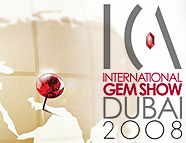 |
Pala International will be at the ICA International Gem Show, which is billed as “the first luxury B2B gem show tailored especially for the loose colored gemstone industry featuring the world’s 120 most prominent colored stone merchants.”
We are pleased to announce that we will be sharing display space with our good friends, the Gobin brothers (who we recently visited at the Sainte-Marie show). Pala will be bringing a selection of our finest colored stones and a collection of exquisite gem crystal specimens. For more information visit the International Gem Show website.
Visit the Pala International Show Schedule for future events. [back to top]
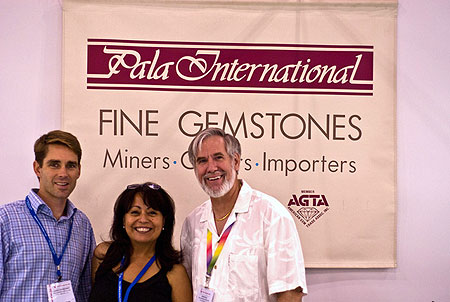 |
| The Pala crew (l–r): Jason Stephenson, Gabrièl Mattice, and Josh Hall. (Photo: Myles Heidenreich) |
We enjoyed seeing our friends at this year’s JA NY Summer Show! The 2009 show will be held July 26–29.
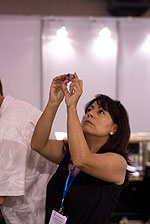 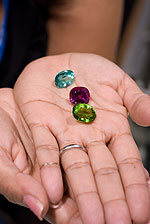  |
| Pala team hard at work. Buying rough (Nigerian rubellite tourmaline), displaying the jewels (paraiba-type tourmaline from Mozambique), and selling them. (Photos: Myles Heidenreich) |
Visit the Pala International Show Schedule for future events. [back to top]
Our sense of color is amused by optics in a world full of varying moods of light and perception of hues. In the gem world we often spend time trying to describe color over the phone, which can be a daunting task since we all have different palettes of color established in our memory. One person may associate red with a fire engine, but connoisseurs of color will delve past the basic red and see the strong orange modifier within fire engine red. Hence an orangey-red would be one example within the continuous nature of color and how individuals perceive it. Even our computer monitors, if not calibrated correctly, can show distortions in the color of the actual gemstone.
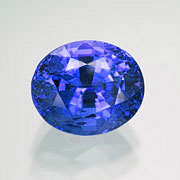 |
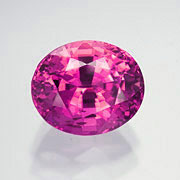 |
| D.I.Y. purple. Open both eyes, stare straight in the middle of the two images (blue and red) then cross your eyes until the two images overlap exactly, producing a purple stone. | |
This month we feature three radiant gems with varying levels of purple, which exhibit subtleties the eye can pick up when we train our brain to evaluate mixtures of color. Purple itself is a mixture of two primary colors, blue and red; try the exercise above to “do it yourself.” The descriptions of the colors that follow may in fact seem askew to someone who has a slightly shifted mental color spectrum then our own.
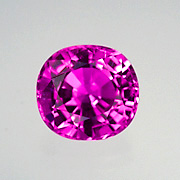 |
| Cuprian tourmaline. This copper-bearing tourmaline from Mozambique weighs 6.82 carats, cushion cut, 12.1 x 11.32 x 7.73 mm. Inventory number 16106. (Photo: Wimon Manorotkul) |
Our first gem has a a vivid pinkish purple, which is commonly referred to as fuchsia. The neon color is a product of naturally occurring copper and manganese within this tourmaline from Mozambique.
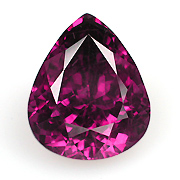 |
| Rhodolite garnet. From Tanzania, 16.98 carats, pear cut, 17.5 x 14.7 x 9.89 mm. Inventory number 5871. (Photo: Wimon Manorotkul) |
Our second feature has more of a dark reddish purple, which takes on a raspberry-type color. This unusual color was produced by a garnet found in a one-of-a-kind deposit in Tanzania.
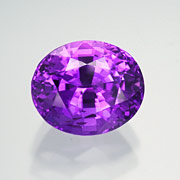 |
| Purple sapphire. Oval cut, 5.25 carats, 10.39 x 8.65 x 6.97 mm. Inventory number 16026. (Photo: Wimon Manorotkul) |
Our third feature takes on a fairly recognizable straight purple color in this picture. But an interesting characteristic of this stone is that the color actually shifts in different light sources. See this color shift explanation.
Interested? Select the inventory numbers above, call us, or email us. [back to top]
A recent find at the Elizabeth R. mine, in the Pala mining district in northeast San Diego County, revealed some spectacular kunzite crystals. The crystal formation is not very well defined but some of the pieces are facet-grade and hold a beautiful natural color. The color is verifiably natural since we can actually trace the kunzite directly from the mine. This batch of kunzite takes on an extremely intense purplish-pink hue. The condition of this material is slotted for a trip to the cutter. Stay tuned for some intense faceted kunzite to be produced from this rough.
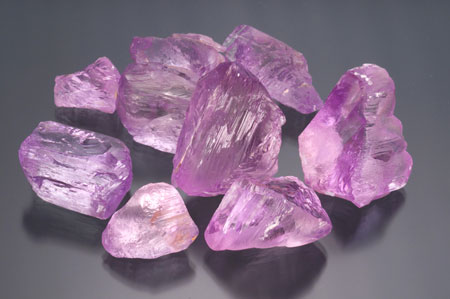 |
| Pure, purple, pink. Some of the facet-grade material produced by the Elizabeth R. (Photo: Wimon Manorotkul) |
The Elizabeth R. mine is situated just above the Ocean View mine which we have been reporting on recently. See the below links to read more about the other recent finds in the Pala Mining District. [back to top]
Prime Art & Jewel, of Dallas, Texas, has been issued an “exempt distribution license” by the Nuclear Regulatory Commission (NRC), allowing it to distribute irradiated gemstones, including blue topaz, according to a July 15 story at JCKonline. While three other licensees are listed by the NRC, PAJ claims to be the first U.S. jewelry wholesaler to receive such a license. [back to top]
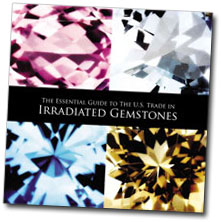 |
In case you missed it at the Tucson show last February, the Nuclear Regulatory Commission’s presentation is available. The presentation, which was delivered on February 8 by NRC Senior Health Physicist Joseph E. DeCicco, has been added to a list of FAQs regarding irradiated gemstones, which we reported on last December.
“The Essential Guide to the Trade in Irradiated Gemstones” is a brochure co-authored by Jewelers Vigilance Committee and American Gem Trade Association. It includes the following topics.
[back to top]
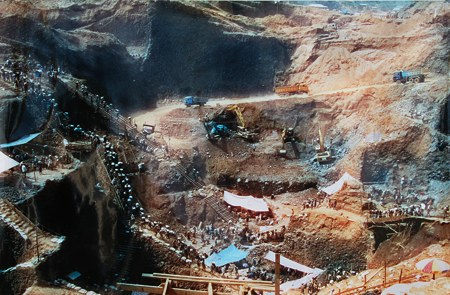 |
| Pharkant Gyi Hmaw jade mine. While much jade mining in Burma has been mechanized, this mine in 2000 still used manual labor in the removal of mining debris. From a Friends of Jade article. (Photo © Fred Ward) |
A landslide on July 30 at a jade mine in Phakant (aka Pharkant, Hpakan) killed at least twenty people, according to a Mizzima News report on August 4. The victims had been searching through a jade mining dump for gold. The location was the Hmawsizar mine in Kachin, northern Burma. The story stated that “[l]andslides frequently kill people in these remote jade and gold mines…, but the news of these tragic deaths rarely reach the outside world.”
The same mining region was plagued by early flooding, due to rivers being clogged by mining debris, as reported by Mizzima on June 23.
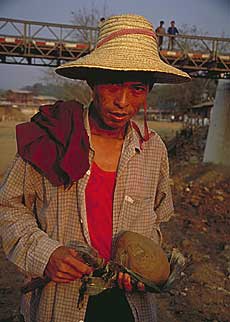 |
| This miner holds a jade boulder at the Uru River tailings dump in central Phakant (Hpakan). The water level in the Uru was much higher this year, due to mining debris. (Photo © Richard W. Hughes, from this story on Palagems.com.) |
[back to top]
As we’ve been reporting in Pala Gem News*, China (in the words of Eurythmics) “still can’t get enough of the stuff.” So summer games visitors would expect to find Burmese jade, considered some of the finest in the world, on offer in Beijing.
 |
| Working their tailings off. This photo, from the AKSYU website, shows people sifting through mining debris in Kachin, desperate to unearth something of value. Such a scene led to the landslide incident reported above. (Photo courtesy AKSYU) |
On August 4, the All Kachin Student and Youth Union (AKSYU) called for visitors to the Beijing games to pass over Burma “blood” jade and gemstones. The fear expressed by AKSYU is that the incorporation of jade into the current games’ medals will whet tourists’ appetite for Burmese jade, which currently is considered materia non grata. (See this recent Friends of Jade item for a look at the Olympic medals’ manufacture.)
Last Friday, India’s “citizen journalism news portal” merinews.com speculated whether jade from Burma—obtained some time back—was actually being incorporated in China’s unique Olympic medals. [back to top]
__________
* Previous Reports: September 2007: Government Anticipating Record Year, Demand from China Pushes Up Prices; January 2008: Burma Trade with China Up 37%; March 2008: Who’s Buying?; June 2008: Burma Anticipates Increased Gem Trade with China. [return to text]
On August 5, Burma’s Central Statistical Organization released its year-end production figures for gems, jade, and pearls. The figures indicate stagnation in jade, pearls, and gemstones such as ruby and sapphire. Only peridot saw a dramatic rise, of over 200 percent. Sapphire saw a drop in production by the same margin. The fiscal year runs April through March. We’ve added these to our Burma Gem Sales and Statistics.
| Fiscal Year | Jade (kg) | Pearls (mommes) |
| 2003–04 | 10,753,813 | 72,575.13 |
| 2004–05 | 14,986,842 | 124,207.09 |
| 2005–06 | 20,390,270 | 177,692.28 |
| 2006–07 | 20,458,279 | 240,595.97 |
| 2007–08 | 20,235,030 | 225,611.40 |
| Gems (in carats) | |||||
| FY | Ruby | Sapphire | Spinel | Peridot | Total |
| 03–04 | 1,959,209 | 1,938,999 | 258,932 | 247,939 | 58,274,843 |
| 04–05 | 3,346,987 | 1,087,979 | 1,440,351 | 166,212 | 47,979,497 |
| 05–06 | 2,298,413 | 428,891 | 1,792,160 | 125,755 | 28,458,831 |
| 06–07 | 1,555,596 | 715,160 | 833,218 | 344,471 | 20,879,219 |
| 07–08 | 1,518,854 | 308,642 | 925,030 | 732,442 | 22,668,368 |
When we accessed the Phakant landslide story on the Mizzima website, the following “Quote of the Day” displayed:
Our buyers are almost all from China, Russia, the Gulf, Thailand, India and the European Union, and we can barely keep up with their demand.
— A Burmese gem merchant in Mandalay
[back to top]
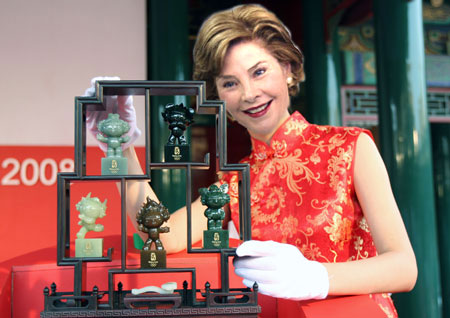 |
| Made in China? Laura Bush examines jade fuwa (Olympic mascots) for country of origin at the Beijing Summer Games. (Photo: Pho Nee News Svc.) |
As anticipated, on July 29, George W. Bush signed the Tom Lantos Block Burmese JADE (Junta’s Anti-Democratic Efforts) Act of 2008 (H.R. 3890). The law bans import of jade and ruby originating from Burma, regardless if the material was processed through a “third-party” country. Also on July 29, the U.S. Department of Treasury tightened existing sanctions of mining and gemstone firms, adding to actions taken April 30 against Burma gem and pearl enterprises.
[back to top]
The 25th Gems & Jade Sale of the aforementioned UMEH is scheduled for August 19–23, 2008, according to an announcement posted July 21 on the Myanmar Ruby Enterprise website. The previous sale was held January 15–19, but monetary sales figures were not released. [back to top]
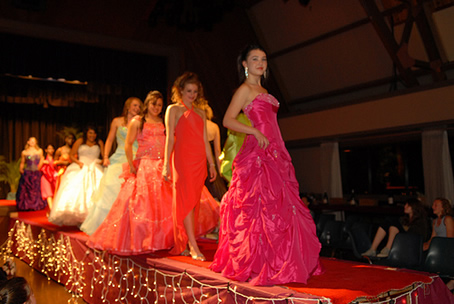 |
| Compassion with Fashion was the benefit brainchild of northern California middle school student Hannah Nell. The event raised $6,000 for Cyclone Nargis aid. (Courtesy FPB) |
On its newly redesigned website, Foundation for the People of Burma announces a weekend of dance, music, and dance workshops in Washington DC, by CityDance Ensemble—all to benefit the charity—on September 6 and 7. [back to top]
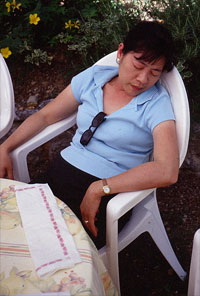 |
| Title: Self-portrait with serviette. Wimon Manorotkul will get a well deserved rest when she leaves Pala International next month. |
Wimon Manorotkul has been photographing gemstones and mineral specimens for Pala International ever since Richard W. Hughes developed Palagems.com, which debuted in late February 2000. At first the photographs simply filled a need: if you’re going to offer an online catalog, you better include photos of what you’re selling. So prior to the launch of Palagems.com, Wimon set about photographing the inventory.
As a gemologist—she’s an FGA (elected to the Fellowship of the Gemmological Association of Great Britain)—enjoys gem testing and photomicrography. “I just love the aesthetic qualities of gemstones at high magnification,” she says.
Now, after seven years of helping Pala clients in their quest for that perfect gemstone, Wimon Manorotkul is leaving Pala, and together with her husband Richard W. Hughes they are going home—to Wimon’s native Thailand, where the couple first met. We wish both of them all the best, but before she leaves us, we’re pleased to feature Wimon Manorotkul as the third artist in our occasional series, FotogFocus.
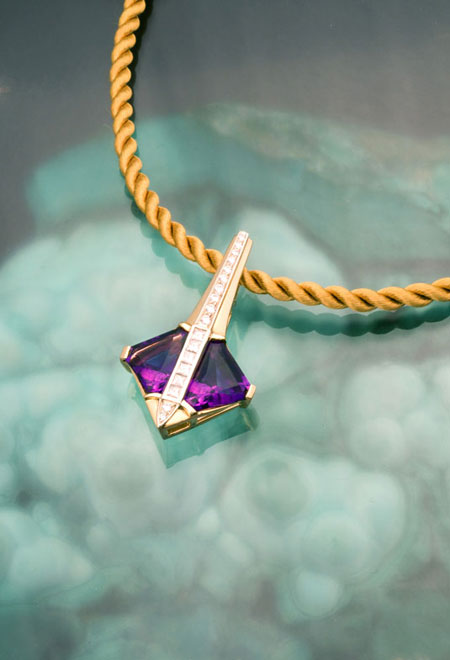 |
| Amethyst custom handmade pendant featuring 7.89 ctw. pair of amethyst trilliants, 0.37 ctw. of princess-cut diamonds, and 0.20 ctw. of round brilliant diamonds, in a yellow and white gold enhancer (available). (Photo: Wimon Manorotkul) |
In this installment of FotogFocus, we get to know Wimon a little better, but we also see the most recent efforts of her talent. Included are photographs, just taken, of selected specimens Bill Larson acquired at this year’s show at Sainte-Marie-aux-Mines, from the Gabriel Risse Collection: a lovely Peruvian selenite and the snail-like adamite from Mexico.
Also included are photographs taken by Wimon for the sixth annual John Sinkankas Symposium, held in April. The subject of the conference was garnet, and Wimon’s images show the spectacular variety of this species. See it all in FotogFocus. [back to top]
— End August Newsletter • Published 8/21/08 —
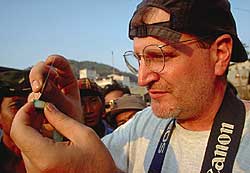 |
The American Gem Trade Association announced yesterday the departure of Richard W. Hughes, Gemological Administrator for the trade group’s Gemological Testing Center. Hughes is known to longtime friends of Pala as a former gemologist and sales associate, as well as developer of the Palagems.com website. Hughes will be leaving AGTA—and the country—at the end of this month for a new opportunity with GemsTV in Thailand. GemsTV, with operations in countries around the world, bills itself as
an integrated manufacturer and television home shopping retailer of genuine colored gemstone jewelry that specializes in manufacturing jewelry in exclusive handcrafted designs, selling directly to customers through a "reverse auction" system via television home shopping and the internet.
Hughes is the author of Corundum (1990) and Ruby & Sapphire (1997), the latter being considered the standard text on the subject as well as one of the finest monographs to be written on a single species of gemstone. Hughes is as much an adventurer as a scholar and accounts of his exploits are always interwoven with dissemination of his expertise. For a taste, visit his website at Ruby-Sapphire.com. We at Pala wish him all the best! [back to top]
As anticipated on Tuesday, July 29, George W. Bush signed the Tom Lantos Block Burmese JADE (Junta’s Anti-Democratic Efforts) Act of 2008 (H.R. 3890). The law bans import of jade and ruby originating from Burma, regardless if the material was processed through a “third-party” country. A reading of the law’s text reveals that the only materials to be regulated are ruby and jade as well as jewelry containing such material.
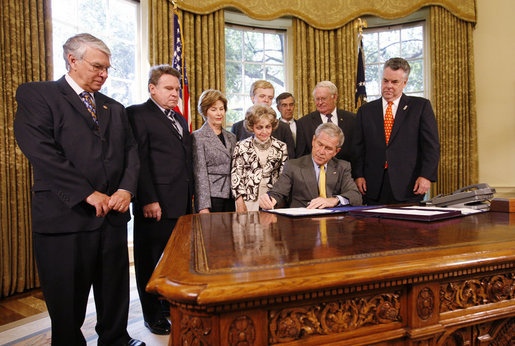 |
| Full of incentive. George W. Bush signs the new legislation as various Congressmen look on. Also attending the signing were Laura Bush, Annette Lantos (widow of bill sponsor Rep. Tom Lantos), and Lantos grandson Siloh Tillemann. (White House photo by Eric Draper) |
The Jewelers Vigilance Committee (JVC) issued a statement clarifying some of the fine points of the new law in a statement, covered in several industry publications such as National Jeweler:
JVC plans to post an overview of the legislation on its website. A JCKonline “Talkback” item last week discusses how the new law will affect the way gemological labs do business.
Last week we noted the dearth of press coverage regarding the passage of the Act by both houses of Congress. Turns out there was a July 15 Associated Press article that was picked up by CBS, following passage of the bill by the House of Representatives. Both that article and a post-signing July 29 AP article state that the legislation “gives Chevron incentives to divest its natural gas program in Myanmar.” Incentives include an “urge” by Congress that investors “consider voluntary divestment” and the threat that “Congress will remain concerned with the matter of continued investment.” If that isn’t incentive enough, “Congress believes that United States companies ought to be held to a high standard of conduct overseas,” and “Congress recognizes the important symbolic value that divestment of United States holdings in Burma would have on the international sanctions effort.” Ouch!
Also on July 29, the U.S. Department of Treasury tightened existing sanctions of mining and gemstone firms, adding to actions taken April 30 against Burma gem and pearl enterprises, as we reported. Newly named in the Department’s press release are the Union of Myanmar Economic Holdings Limited (UMEH), which holds biannual jade and gemstone sales in Burma, and which counts among its subsidiaries the Myanmar Ruby Enterprise and Myanmar Imperial Jade Company Ltd.
The 25th Gems & Jade Sale of the aforementioned UMEH is scheduled for August 19–23, 2008, according to an announcement posted July 21 on the Myanmar Ruby Enterprise website. The previous sale was held January 15–19, but monetary sales figures were not released. [back to top]
On July 22, both houses of U.S. Congress approved the (late Rep.) Tom Lantos Block Burmese JADE (Junta’s Anti-Democratic Efforts) Act of 2008 (H.R. 3890), according to a press release issued byJoseph Biden (D-DE), a champion of the bill in the Senate. The Irrawaddy reported that the vote was unanimous. George Bush is expected to sign the bill into law.
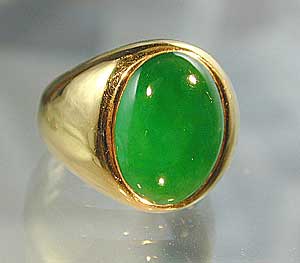 |
| Even if sourced through a “third-party” country like Thailand, a ring such as this splendid 17.22–ct. fei-ts’ui (imperial jade) can no longer legally be imported into the U.S., under the terms of the new act. (Photo: John McLean, from an article on Palagems.com) |
The Biden release states that, amongst other things, the law will “[t]ighten the economic sanctions Congress imposed in 2003 by outlawing the importation of Burmese gems to the United States.” Previously such gems were allowed to be imported via third-party countries.
The bill’s passage was not covered in the U.S. press (with the exception of alternatives like Democracy Now!), likely because it might have to be noted that a company with close ties to Condoleezza Rice and bill co-sponsor John McCain was exempted from the act. Section 15 of the bill is devoted to the exclusion of Chevron, which maintains a 28% “non-operated” interest in Burma’s Yadana natural gas pipeline project. The company famously named a supertanker for the future Secretary of State; it has contributed to the Arizona Senator’s presidential campaign, and at least three of his staffers and fundraisers have lobbied on behalf of the oil giant. McCain’s opponent, Sen. Barack Obama, also has received his share from Chevron.* Simply put, the Yadana project is a cash pipeline for Chevron: earlier this month, oil and gas trade in Burma’s last fiscal year was pegged at almost ten times that of gems and jewelry, growing nearly 300% from the previous year. And Chevron bears no operational burden.
The Guardian reported July 23 that Chevron, the largest U.S. business in Burma, originally was bound by the bill to pull out of the country, but lawmakers lost their nerve because “[t]he US stake in Yadana would be handed over to Chinese or Indian companies if Chevron was forced to sell, the company argued.” The Myanmar Times, in an Agence France-Presse story prior to the Senate vote, quoted a Chevron official as saying that, following a pullout, the oil company would have to pay Burma a capital gains tax, estimated at $500 million. Last fall, The Hill quoted director of the U.S. Campaign for Burma, Jeremy Woodrum, who begged to differ regarding China’s ability to step in: “There is a lot of Chinese investment but they’re nowhere near approaching the level of being able to replace U.S. and E.U. investment in the country.”
As we’ve reported often in Pala’s Gem News, China and India have picked up the slack in Burma’s jade and gemstone market following the imposition of sanctions worldwide. It remains to be seen whether the third-party countries, which have supplied the U.S. with Burmese gems, will enjoy increased trade with China and India, once Bush signs the new bill.
__________
*See Center for Responsible Politics and Public Campaign Action Fund for somewhat conflicting information on Chevron contributions to the presidential campaigns. See FactCheck.org for information on oilmen involved in Obama’s campaign. [back to text]
Pala International heads to the East Coast later next month for the trade-only JA New York Summer Show. Stop by to see one of America’s largest selections of fine colored gems.
 |
When: July 27–July 30, 2008
Where: Jacob K. Javits Convention Center
Hours: AGTA Gemstone Section
Sunday, July 27: 9:30 AM – 6:00 PM
Monday, July 28: 10:00 AM – 6:00 PM
Tuesday, July 29: 10:00 AM – 6:00 PM
Wednesday, July 30: 10:00 AM – 3:00 PM
Pala International is in booth 1361. See the JANY website for more information. Visit the Pala International Show Schedule for future events. [back to top]
The young and famous Mozambique tourmaline beauties are the talk of the town once again. This time it’s not a question of where they grew up or if in fact they are gorgeous, it’s more about what we can call them. Paraiba-type, paraiba africanas, cuprian elbaite tourmaline, etc… Call them what you want, they’re always in the news because they’re absolutely beautiful, with mesmerizing colors. This month we feature a couple of large ones (Note: The second stone was subsequently sold) to remind everyone how amazing this material is, and why we all fell in love with it in the first place. These two featured stones are the largest to be cut from the parcel of Mozambique rough that was purchased by Pala about three years ago.
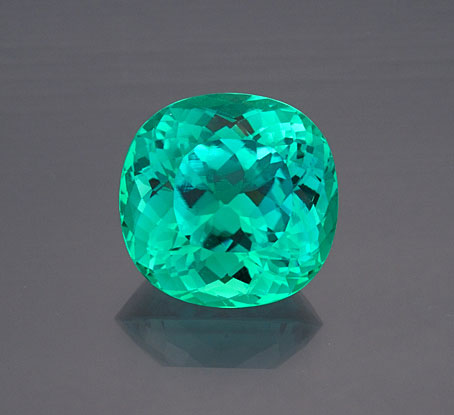 |
| Big & Beautiful I. Paraiba-type tourmaline from Mozambique, 70.74 carats, cushion cut, 25.05 x 24.68 x 18.38 mm. Inventory number 16167. (Photo: Wimon Manorotkul) |
The young copper-bearing children of tourmaline heritage have exploded on the runway of gemstones in the past twenty years. Their recent emergence into the gem market from Brazil, Nigeria, and now Mozambique, has been sudden, if we look at the history of tourmaline being described in literature dating back at least 500 years. Their historic parents—the old green, blue, and red varieties—have been overshadowed by the fluorescent neon colors of the next generation of tourmalines.
In the next twenty years, we could quite possibly be seeing the dissemination of the material around the world, and the exhaustion of the deposit in Mozambique. As they say “history will repeat itself,” and new gem discoveries usually are short lived. Sometimes we have to use the past to foreshadow the future, while still enjoying what’s available in the present.
Interested? Select the inventory number above, call, or email us.
See also:
[back to top]
 |
In April, on the way to the Basel jewelry fair in Switzerland, Pala’s Gabrièl Mattice (above right) accompanied clients on a visit and private tour of the French National Museum of Natural History. Also along for the trip were The Collector Fine Jewelry’s Jeanne Larson and Kate Donovan (left and center, above). The visitors bore gifts and in return received the personal attention of the museum’s chief-curator, François Farges…
Read the full story—“American Girls in Paris”—here. [back to top]
Photos and cutting by Meg Berry (except as noted). Berry has a long career as a masterful carver of gemstones; see this 1992 profile on Palagems.com.
The Atocha—the Spanish galleon Nuestra Señora de Atocha—and its vast treasures are famous the world over. Pieces of its haul have landed in the hands of collectors from around the globe. One interesting emerald crystal in particular has made its way from Colombia aboard the Atocha, then sunk in the Gulf of Mexico in 1622, discovered in the deep 363 years later, carried to dry land again, and sold to a collector—finally being given to us to cut and document the cutting process.
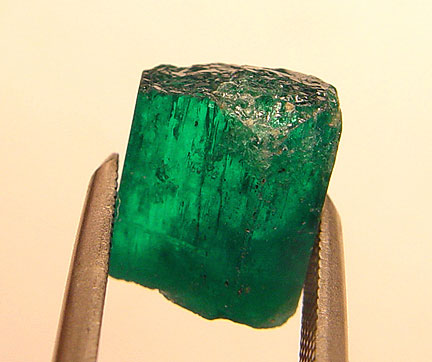 |
As you can see, the crystal began with an intense, slightly bluish-green hue. As with most emeralds the clarity was hindered by the jardin, or garden, of inclusions. The focus of this project was to simply facet the emerald without any other enhancements, leaving the garden exposed, showing its natural beauty.
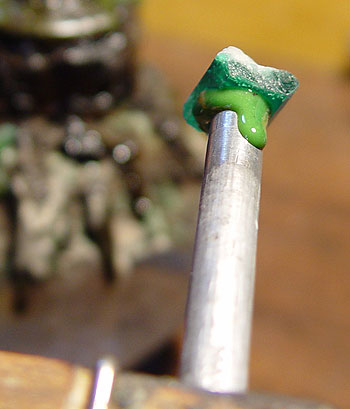 |
The process is started by adhering the crystal to the dop stick and pre-forming the basic shape of the gemstone.
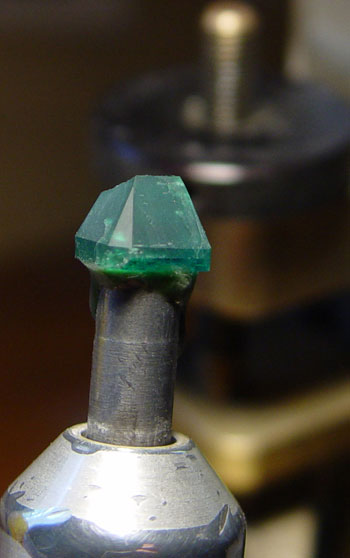 |
Cutting the emerald into a rough shape readies the emerald for the long polishing process.
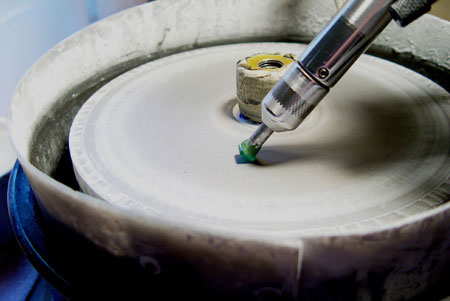 |
Starting with a coarse-grain polishing wheel cuts away the faces of the emerald and starts to define where the ultimate facets will be.
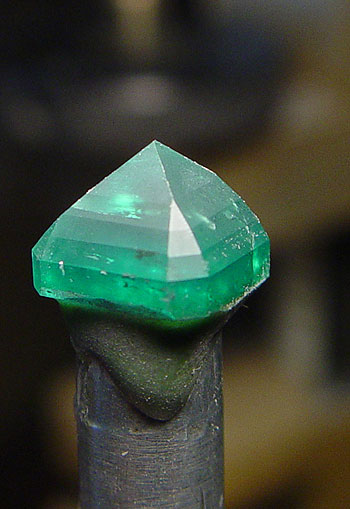 |
Gradually moving from coarse grain to finer and finer grain, the facets become more defined and lustrous.
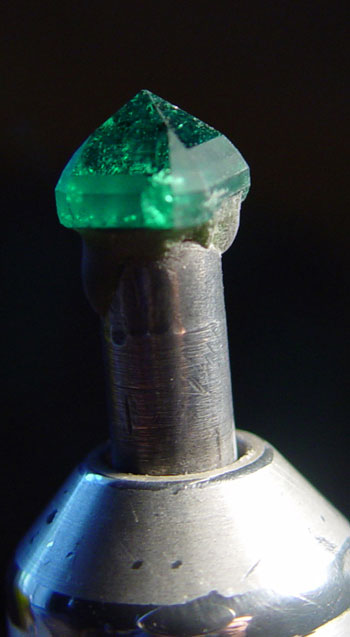 |
Ultimately the emerald is buffed with an extremely fine-grain polish that gives the gem its full and lustrous beauty.
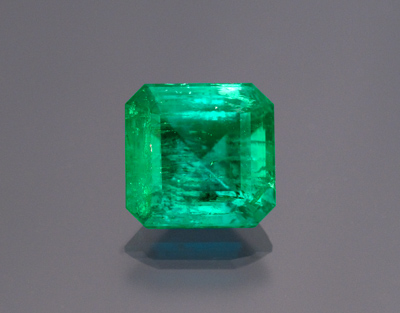 |
| Faceted emerald. Rough weight 6.79 carats. Cut weight 2.08 carats, 7.92 x 7.66 x 5.47 mm. (Photo: Wimon Manorotkul) |
[back to top]
 |
The Gemmological Association of All Japan issued a research lab report identifying an imitation paraiba-type tourmaline, consisting of synthetic beryl containing a high concentration of copper (Cu). The report states that such material is manufactured by Tairus Created Gems of Russia, which introduced the product to the market in September 2007. [back to top]
Gem and jewelry trade figures for Burma’s most recent fiscal year show growth of 118% over the 2006–07 period. As before, gems and jewelry ($647 million) came in third, behind oil and natural gas ($6.043 billion) and agricultural products ($1.140 billion). The total trade volume was up 8% from $8.1694 billion to $8.860 billion. The figures were reported last week by The Myanmar Times.
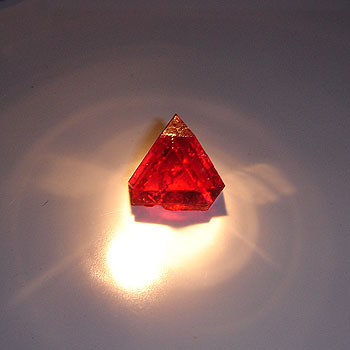 |
| This 1.5-cm. twin macle (twin) spinel crystal was examined on a trip to Burma in 2005. (Photo: Bill Larson) |
As can be extrapolated from the above figures, foreign investment is largely limited to the energy sector in Burma, with the United Kingdom in the lead, as reported by The Associated Press. The Spectator columnist Elliot Wilson has written that Burmese are reluctant to part with their money, choosing to maintain their savings in gems and precious metals, as a hedge against future devaluation of the local currency.
As always, see our updated Burma Gem Sales and Statistics. [back to top]
Agence France-Presse confirmed that an 11-day auction of gems, jade, and pearls was being held June 24 through July 4 in Yangon. No other details were released.
General Shwe Mann, who is rumored to become Burma’s next military chief, has stated that future leaders of the country need to have a thorough knowledge of two key areas—gems and rice—according to Aung Zaw, editor of The Irrawaddy, in a June 27 opinion piece.
Some farmers are turning from rice to poppy cultivation in order to meet the demand for opium amongst gold and jade miners as well as timber loggers in Kachin state, according to a June 30 article on the “citizen journalism new portal” merinews, based in India. [back to top]
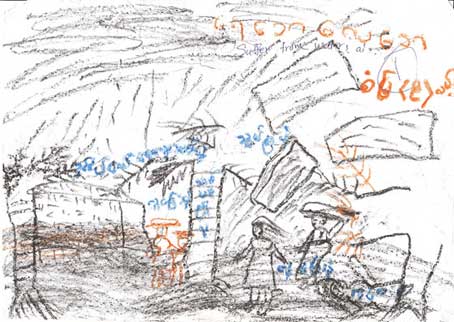 |
| Artwork by a child who survived Cyclone Nargis. (Courtesy FPB/Gitameit Music Center) |
The Foundation for the People of Burma continues to raise money for its locally-based efforts to aid survivors of Cyclone Nargis. The non-profit humanitarian organization is on the way to a goal of raising $2 million. Several updates are accessible, including FAQs regarding donations. [back to top]
— End July Newsletter • Published 7/16/08 —
Pala International heads to the East Coast later next month for the trade-only JA New York Summer Show. Stop by to see one of America’s largest selections of fine colored gems.
 |
When: July 27–July 30, 2008
Where: Jacob K. Javits Convention Center
Hours: AGTA Gemstone Section
Sunday, July 27: 9:30 AM – 6:00 PM
Monday, July 28: 10:00 AM – 6:00 PM
Tuesday, July 29: 10:00 AM – 6:00 PM
Wednesday, July 30: 10:00 AM – 3:00 PM
Pala International is in booth 1361. See the JANY website for more information. Visit the Pala International Show Schedule for future events. [back to top]
 |
| This 42.71-carat imperial topaz comes from Ouro Preto, one of the localities featured in the tour. And it’s available, Inv. #1645. |
After our mention in the April Gem News of a tour associated with the Brazilian “FIPP” gem fair coming up in August, we received a note from Tour Guide Brazil, which offers a tour of several different localities in the state of Minas Gerais.
The tour includes the topaz mines and markets of Ouro Preto, an emerald mine in Nova Era, and various mines and markets in and around Governador Valadares, Teófilo Otoni, Itaobim, and Araçuaí. [back to top]
 |
The 12th Brazil Gem Show, billed as the largest in Latin America, will be held June 25–28, in Governador Valadares.
On Monday, JCK’s Gary Roskin announced he’ll be attending the show, and that he plans coverage with plenty of photos. [back to top]
For in them you shall see the living fire of the ruby, the glorious purple of the amethyst, the sea-green of the emerald, all glittering together in an incredible mixture of light.
— Roman Pliny the Elder on Opal, 1st Century AD
In general when we hear “opal” we think Australia, but there are a few areas in Mexico that produce some of the finest opal with play-of-color on the planet. The exceptional ones also include another dimension of color. When all the components align, a full spectrum of color dances from within the heart of the gem and jumps out of the stone three-dimensionally, almost floating above the surface. The local Mexican miners called the light-and-color dance “floating light” or lloviznando.
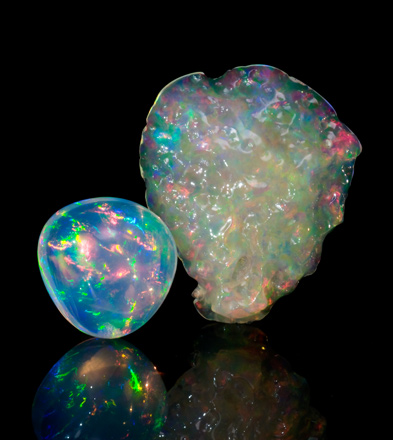 |
| Rough and cut lloviznando opal. Cut: 22.47 carats, 18.97 x 18.3 x 11.97 mm. Rough: 31.66 carats, 35 x 30 x 7 mm. From the Gladnick Collection. More photos available here. These pieces have been sold. (Photo: Wimon Manorotkul) |
This month’s feature is by some standards one of the best from the Magdalena mining district in Jalisco, Mexico. A true spectacle of lloviznando: you can actually spin it around in your hands and interact with the play-of-color…
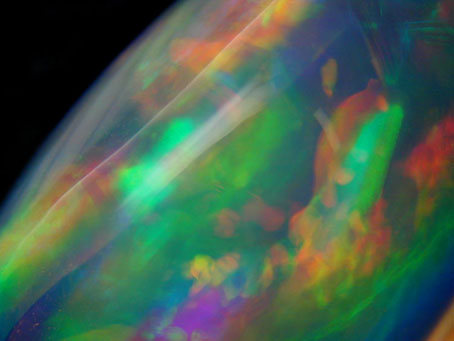 |
| Light rise over Planet Opal. A close-up view of the source of the color in this month’s featured gemstone. From the Gladnick Collection. (Photo: Jason Stephenson) |
Read more—and see more—about this month’s featured stone here. [back to top]
Last month Bill Larson, in his capacity as board member of the American Gem Trade Association, received a note from AGTA Secretary Betty Sue King about an article in San Francisco Magazine.
All too often, our organization is scrutinized, criticized, and bashed. This is an excellent article about one of our members who has loads of praise for the AGTA. Margie Rogerson has been a member for three years and plans to enter the Spectrum [Awards] competition in the platinum category. I called Margie to thank her for her enthusiastic spin on stones and the AGTA.
For those with a 41-year memory, Margie Rogerson might be known for creation of the micro mini-dress, which launched her career in couture during San Francisco’s Summer of Love. Since then, she’s developed a clientele that includes Bob Dylan, Roger McGuinn, Joni Mitchell, and Johnny Winter.
For the last nine years Rogerson has been designing austerely elegant platinum jewelry, employing lots of colored stones. Here’s the article, from San Francisco Magazine.
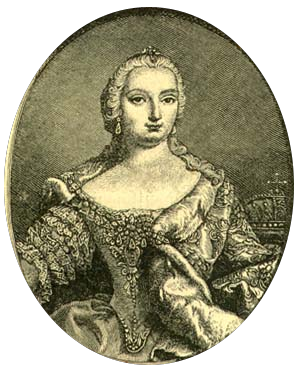 |
| On couture’s cutting edge four decades ago, Rogerson cast a backwards glance in the 1890s, viewing the jewels of the Hapsburgs, such as 18th century’s Maria Theresa (above), as well as those in private European collections. But Rogerson’s designs are anything but Baroque… |
[back to top]
At least 11 people were killed, and 22 hospitalized, when the Yayni (Yeni) Creek in the “Valley of Rubies” overflowed its banks and protective levees, according to a June 13 Mizzima News story. The creek’s flooding caused destruction of houses as well as landslides. The rain began in the wee hours of June 12, and the severity apparently was exacerbated by local mining mechanization, which clogs the creek, allowing for easy flooding.
| No, this is not the Irrawaddy delta… Mogok residents—whose structures’ foundations already are raised as a protection against heavy seasonal rains—shore them up lest they be swept away altogether by a creek choked with debris from mining mechanization. (Photo: Mogok Media) |
A June 14 follow-up story was reported in the official New Light of Myanmar, stating that the region received “record” rainfall of 8.07 inches. On Monday, June 16, the daily reported nearly two more inches of rain falling in the 24 hours prior to 09:30, June 15. [back to top]
 |
Gem traders in Burma are looking forward to the 5th China–ASEAN Expo (CAEXPO) in October in order “to deepen their penetration of the Chinese market, according to a senior CAEXPO official, Qin Yizhuang, it was reported in The Myanmar Times in its May 26 edition. The article quoted customs statistics as stating that Burma exported $44.399 million worth of gems to China in 2007.
A May 19 story stated that Burma had a 116-booth presence at the last CAEXPO Commodity Trade pavilion. [back to top]
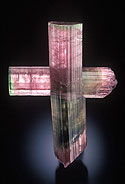 |
In this occasional series, we focus on the artists behind the camera. In our second installment, we feature American photographer Jeffrey Scovil, whose image of an elbaite cross is pictured at right.
Jeffrey Scovil has a curator’s eye for detail. Not surprising for someone who, as a boy growing up in Westport, Connecticut, assembled a natural science “museum” in the basement of the family home—“minerals and fossils, bee and wasp nests, coins and butterflies.” Read on… [back to top]
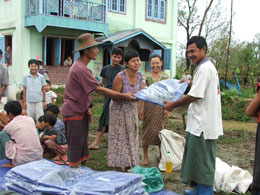 |
| Foundation for the People of Burma relief workers distribute tarps. (Photo: FPB) |
You can help these relief groups—who, as locals, are able to work quite efficiently—by giving generously. [back to top]
— End June Newsletter • Published 6/19/08 —
Marliese Weed of California, and Theresa and Gary Hurd of Tennesee have filed $5 million lawsuits against Knoxville, Tennessee-based Jewelry Television, according to stories in the Knoxville News and Sentinel. Both suits claim that treated, low-cost andesine-labradorite was being marketed by JTV as being rare, desirable, and natural. The Weed complaint is available from KnoxViews.
On June 2, News and Sentinal quoted Jewelry Television as saying that the gemstones were confirmed by labs as being “natural and untreated,” while acknowledging that it had discovered a source in January that had treated its material. Such information was conveyed to customers when it became available, according to the report.
For background on the story, see our April and May Gem News editions. [back to top]
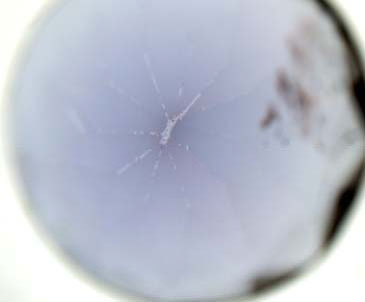 |
| In immersion. Abraded coating reveals the lighter, inherent color of the tanzanite. (Photomicrograph courtesy Christopher P. Smith, AGL) |
In a joint press release on May 23, the American Gem Trade Association Gemological Testing Center (AGTA-GTC) and American Gemological Laboratories (AGL) announced the identification of a new coating treatment on tanzanite, heretofore undetectable.
Evidence of the coating was detected via “abrasions along facet junctions and at the culet where the coating had worn off, as well as a subtle iridescence when viewing the surface with reflected light,” according to the release. X-ray fluorescence spectroscopy revealed the coating to be colored by cobalt.
Because the sample that was examined contained mainly “smaller calibrated stones,” the release cautioned that “[f]ine color tanzanite in this size range is rarely sent to a lab and therefore would avoid detection unless closely scrutinized.”
For a look at tanzanite grading, see this article from AGTA-GTC. [back to top]
We received the following note from Thant Zin, from Burma. He alerts us to aid efforts by members and devotees of Monle monastery, at Inn-da-gaw, Bago Division, north of Yangon. A relief team has made two relief “laps” already, most recently to Pyapon, Labutta, and Bokale, towns that were nearly in the direct path of Cyclone Nargis. (For maps, see UNOSAT.)
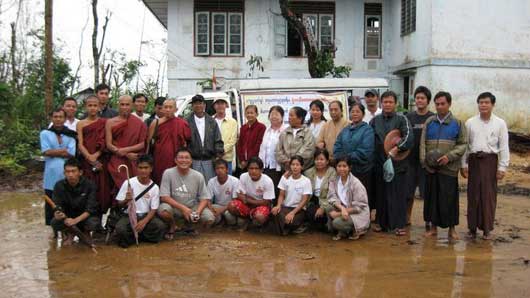 |
| These Monle devotees and representatives, are pictured in conjunction with their first “relief lap,” which began May20, to the cyclone-devastated Irrawaddy delta. See photos of volunteers in action here. (Photo: Mogok Monle Website) |
Hi,
I’m Thant Zin from Myanmar. I would like to tell you that we (MONLE AID) are going to donate foods + clothes + roof shelters to Nargis victims and survivors. We also got a line to approach worst area around Irrawaddy delta. That’s why we are inviting many people to give supports for victims via us.
Also Monle Sayadaw started 1,200 robes for monks+ rice bags donation for Nargis victims. We went to 3 towns (Kawh-Mhu + Kun-Chan-Kone + Dae-Da-Ye) last 20th May 2008 and donated robes and foods there. We have seen many pitiful victims who are homeless and hungry without water there and some people near sea are drinking coconut juice to keep their lives. You will also hear much about how people get trouble in Nargis Cyclone area. We decided to continue our donation to next towns between Irrawaddy Division. We will donate easy foods such as fried flour (bar-la-choung-kyaw) + fried peals (myay-pae-kyaw) + cooked rice for 10,000 people and more than 100 roof shelters in coming 2nd lap (Bo Ka lay area + Latputta). [Ed.: This lap was to have begun May 28.]
Please tell your friends and USA Monle devotees about this. From now, we’ve got 48 hours before we leave for 2nd lap.
The more we support them, the more people will be relieved from food [shortage], homeless, diseases that is being spread out and death!
Please read about MONLE AID and photos.
With Metta and thanks,
Thant Zin
(M.D. Treasure Villa Gems)
Anyone who is in mood to give supports for cyclone victims via MONLE AID, contact me: (95999)-25065, (951)-664414, (95951)-56008 and mogokmonle@gmail.com.
[back to top]
This month, the sheer immensity of devastation in southern Burma and Sichuan, China—on the heels of the flooding in Merelani, Tanzania—gives us pause.
In this issue:
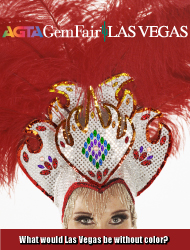 |
It’s time for the JCK Las Vegas show. Pala International will be there in force, with one of America’s largest selections of fine colored gems. The AGTA Pavilion opens one day early—Thursday, May 29—before the main JCK Show.
When: May 29–June 2, 2008
Where: Venetian Hotel Grand Ballroom adjacent to the Sands Expo & Convention Center, Las Vegas, NV
Hours: AGTA Gemstone Section
Thursday, May 29: 10:00 AM - 6:00 PM
Friday, May 30 to Monday, June 2:
9:00 AM - 6:00 PM
Booth: AGTA Pavilion, booth 34308
We look forward to seeing our many friends there. Visit the Pala International Show Schedule for future events. [back to top]
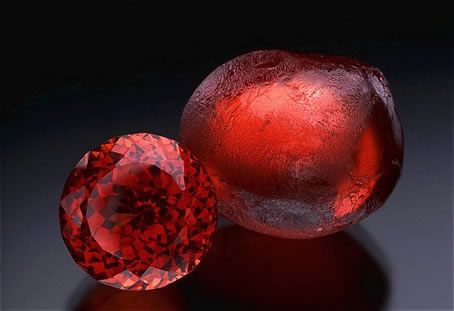 |
| This Malaya garnet rough-and-cut pair, shot by photographer Jeff Scovil, is one of several such photos of Bill’s collection on the Ste.-Marie website [since removed]. |
Pala International’s Bill Larson attends this event every year, held in the midst of the Alsace wine region of northeastern France. See his report from the 2007 show.
What: Euro-Mineral/Euro-Gem
When: June 26–29, 2008
Where: Sainte-Marie-aux-Mines, France
Bill looks forward to seeing you there. [back to top]
The gap between the gem and mineral world seems to be closing, as the agate lickers have evolved and the large corporate gem houses return to nature. Well, maybe not that extreme, but more awareness of gem materials has brought many stone collectors to delve into the source material and mineral collectors to have some appreciation for faceted stones. Finding beautiful and rare collectable pieces of nature is a endeavor at the heart of man.
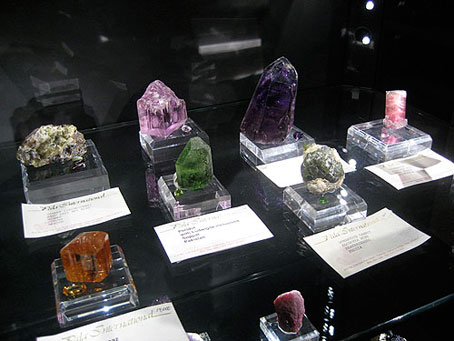 |
| Rough & Cut Display in Dallas. (left to right) Back: Mexican andradite garnet, Afghani kunzite, Mexican amethyst. Middle: Russian demantoid garnet, Californian pink tourmaline. Front: Brazilian imperial topaz, Pakistani peridot. (Photo: Jason Stephenson) |
The colored stone industry is far more evolved and commercialized as faceted gems find their way out of the jewelry store onto countless websites, or spinning around on late night television networks. A seemingly endless supply of goods—but in the words of the X Files, “the truth is out there.” If one chooses to collect gems and go down the rabbit hole of knowledge, there is much to be explored and inspired by.
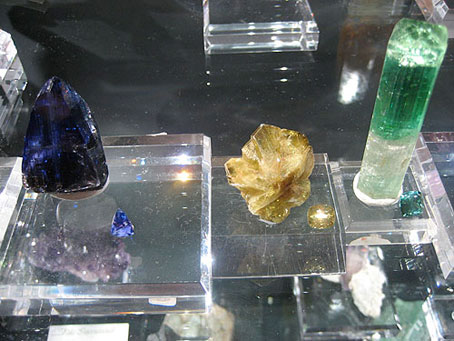 |
| Gem Crystals Indeed I: Tanzanian tanzanite with rich bluish-purple hue and some gemmy sections; Brazilian chrysoberyl with well-formed sixling; Afghani tourmaline in a large, cigar-sized crystal with bluish-green color. (Photo: Jason Stephenson) |
The mineral industry has mainly come limping out of the old mining localities around the U.S. A small group of geologists, explorers, and rock hounds has amassed collections that until recent times have been very esoteric. More recently there has been a quickening of new collectors onto the scene, driving prices skyward and exposing the true rarity and beauty of these specimens. A branching network of interested parties siphoning up the species that turn them on and turn them into the new layer of collectors.
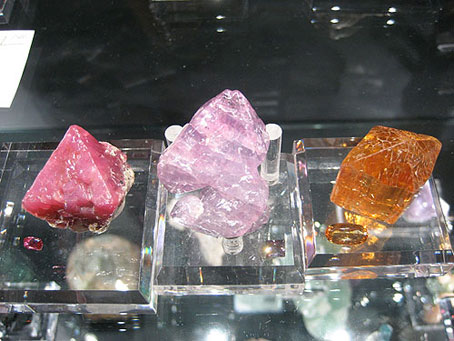 |
| Gem Crystals Indeed II: Tanzanian spinel in a strawberry-colored octahedron; an unusual Burmese lavender spinel; short and stocky Brazilian imperial topaz. (Photo: Jason Stephenson) |
As we join these two worlds we start to understand that gems are minerals in their purest form and actually start out in an assortment of shapes and sizes from unusual corners of our Earth. The ultimate in collecting is to display a well formed crystal with a representative sample of the same species in a faceted gem. To pair a rough-and-cut takes some strategy; from matching the pure color, to ideally having material from the same region within a single country.
Enjoy a few pictures from our display at the Dallas Fine Mineral Show earlier this month.
The Dallas show is mainly minerals, but gemstones are usually included to some degree. This year we expanded our display to include some cut stones paired up with their rough crystal counterparts, as well as introducing some high-end custom jewelry into the mix. Displaying these three stages of gem materials gained a lot of attention, as kids and adults alike were able to see the transformation from raw stone to a unique piece of jewelry.
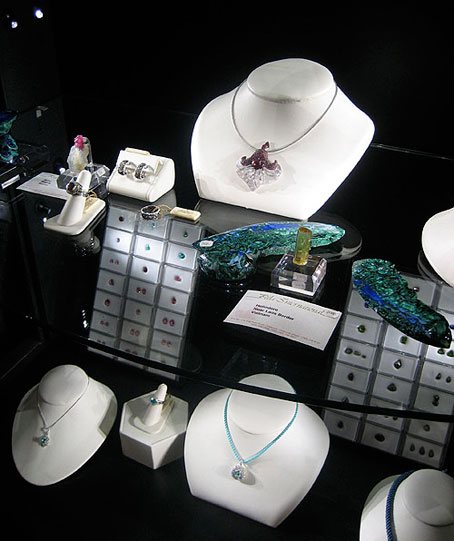 |
| Pala’s display showing the full spectrum from crystals to cut gemstones to jewelry. (Photo: Jason Stephenson) |
For example, we displayed some large pink tourmaline crystals from the Himalaya mine in San Diego, which were actually mined by Pala over the years. Some of this material was cut into beautiful pink gemstones that were also on display in an array of shapes and sizes. The story of pink tourmaline ended in a one-of-a-kind white gold ring, set with diamonds on the side of the band.
See these links for more images and video of Pala’s display in Dallas, courtesy The Vug:
Well, if you can, you would be on track to start a treasure hunt for the elusive red beryl in southwestern Utah. Find your way to Beaver County and start climbing up the Wah Wah Mountain range. Keep an eye out for white rhyolite volcanic tufts that house the rare little red crystals. Once you find this rock type it’s all about crushing and sorting through the rubble. Be prepared to stay for a while because it’s been estimated that, on average, out of every ton of rock only 0.5 carats of facet grade material is found.
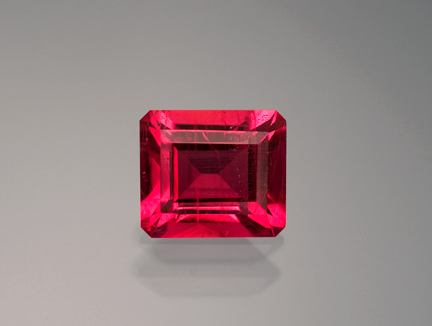 |
| Red beryl. Emerald cut, 1.24 cts., 7.23 x 2.25 x 3.97 mm. Inventory #15614. (Photo: Wimon Manorotkul) |
The average-size faceted stone is under a half carat and usually is included. This month’s featured stone is quite exceptional, weighing in at 1.24 cts. and eye clean. A gooseberry red hue with a pleasant emerald cut showing nice brilliancy.
For more on red beryl, see:
My... how time flies!
May 16, 2008, marked my working with Pala International for an incredible 20 years. Believe me when I say, It has been a “Golden Ticket” ride.
During this time, I have gained immeasurable experience in the fine points of selecting, purchasing, and selling gemstones in the prestigious echelons of “private collectors.”
With a dedicated focus on origins and rarities, Bill Larson (president and owner of Pala International) became my mentor and advisor. His highly developed sense of mineral quality has guided me to continually sharpen my own eyes as to what makes a particular stone rare.
 |
It’s always an enjoyable challenge to distinguish the aspects of a stone that will qualify it as the possible addition to a private collection. Not only do I have to know the rarity of the stone in my hand, but it also has to be compared with what is already found in existing collections—both privately owned and those of museums.
The ability to detect the slightest differences in nuance, due to origin, is vital. It is also the reason why so many connoisseurs who wish to build world-class collections turn to Pala. These collectors have expressed a desire for the very finest. Our aim is to introduce the future collector to this higher level of acquisition by educating them as to the scarcity of the gemstone or mineral specimen they are considering.
Now, with their blessing, our readers will get a chance to take an occasional peek into some of the caches that I have been so privileged to help build.
With the aid of friend and Pala International photographer Wimon Manorotkul, we will begin a new feature on our website, called “Private Eyes.” In this section you will have entrée to stones that most people never get to see. I will accompany each gemstone with an explanation as to why it was singled out for a collection, and what separates it from other stones of its variety.
Understandably, names and locations for each of these treasures will remain unavailable.
I hope that this new section of our website will be as much a learning experience for you as it is fun to behold. Because what value is passion and knowledge if it’s not shared? Enjoy…
Gabriel Mattice, G.G.
Gemstone Sales & Acquisitions
[back to top]
Gene Goldsand, a self-described “trafficker in scientific and medical equipment and microscopes,” as well as a longtime student of gemology, notified us of the availability of what are, in his estimation, “the best artificial light available”: 300-watt ILC Cermax Xenon Arc Lamp Illuminators.
In my well informed opinion (about lightsources) these are about as good as it gets, putting out some 3500 lumens of 6000 to 6500 K light with a CRI between 95 and 99. The Cermax lamp collects much more light than the usual XBO short arc lamp.
Goldsand is especially eager that these lamps get into the hands of “gemology types,” and has even fabricated the cables for these lamps, which had been discontinued. His plan is to approach the seller for a reduced-price bulk purchase and to offer fellow buyers the cables as an add-on. Because the seller allows pick-up, interested folk in Southern California especially are urged to consider acquisition of these units. See more information and contact Goldsand through this GemologyOnline post. (You must join the forum to reply to him; if there’s a problem, email us at Palagems.com.)
 |
| Got a light? Pictured here is the power supply for what Gene Goldsand calls first-class illumination. Goldsand is a fan of our reprint, “Buying and Selling Gems: Which Light is Best?” by William J. Sersen and Corrine Hopkins. |
[back to top]
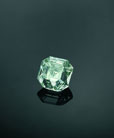 |
| See photos of the 100-ct. diamond and this green diamond here. |
The largest colorless diamond to be auctioned in 18 years will be offered next week, May 28, according to a Christie’s Hong Kong press release. The stone was cut from a 460-carat rough, the modified shield shape featuring 92 brilliant facets. Also offered at the sale is a 10.63-carat green diamond. To view stunning photos, see our April 28 Gem News item on Palagems.com.
Last week, May 14, Christie’s Geneva sold a 13.39-carat blue diamond, which fetched $8.9 million. It was touted before the sale as “the largest ever to be sold at auction,” according to a press release. (See photo here.). Post-sale stories, such as this one, qualified the stone as the “most important colored diamond” to be sold at auction in the last ten years.
Here’s a genuine record-setter, from Sotheby’s Geneva. A rare, 3.73-carat, fancy vivid blue diamond sold last Thursday for $4,955,097, with a per-carat price of $1,328,444—a new world record for any gemstone at auction, according to a press release. (See photo here.) News reports named the buyer as Laurence Graff. The sale tops a record, which we reported, set just last October by the auction house’s Hong Kong branch. (See photo
At a total of $56 million, the Magnificent Jewels sale, which was dedicated to the collection of philanthropist Lily Marinho (and wife of Brazilian television kingpin Roberto Marinho), is second in total proceeds only to a 1993 record set by Sotheby’s in 1993. [back to top]
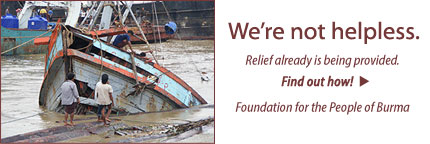
We suggest you give generously to the Foundation for the People of Burma. FPB provides humanitarian aid to Burmese people of all ethnic backgrounds and beliefs. FPB already is distributing food to refugees on the outskirts of Rangoon and the Irrawaddy Delta.
Every gemologist and aficionado of fine colored gemstones holds a special place for Burma in her or his heart. Its production of the most highly valued rubies is legend, having endured at least 1,500 years of human dramatics (Hughes, pp. 304–305), and most recently being strained by two centuries of colonial and military rule. Chinese merchants continue to clog the Burma gemstone markets, as voices from inside and outside the region debate the prudence of prohibition. Meanwhile, preparations proceeded for a contentious constitutional referendum, scheduled by Burma’s rulers for last Saturday.
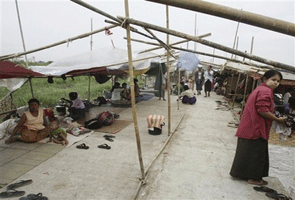 |
| Pale shelter. A tent city erected for those displaced by Cyclone Nargis. (Photos: Irrawaddy) |
Just a week before the referendum was to take place (and it did take place in some parts of the country), Cyclone Nargis—meaning “delicate daffodil” in Urdu, and the first named storm to come out of the North Indian Ocean this year—pounded the southern coast of Burma’s populous Ayeyawady state. The region is home to the many mouths of the Irrawaddy River—a “rice bowl” of the country that had fed many hungry mouths—and to a thriving fishing industry. The storm continued its devastation, skirting the coast, and wrecking Burma’s former capital, Yangon (Rangoon).
Estimates of Nargis’s death toll climb by increments of 10,000. As an Australian academic familiar with Burma said in a story on May 6, “We’ll never know how many died,” he said. “This a country that hasn’t had a full census since 1937.”
Statistics—accurate or otherwise (and we at Pala are keepers of our own…)—hardly matter to people who are putting their lives and livelihoods back together. Unpleasantly, but not unexpectedly, Burma’s rulers have been reluctant to exhibit impotence by accepting foreign aid—reminiscent of George W. Bush during a particular domestic natural disaster in 2005; the irony of a tongue-lashing from Laura Bush on May 12 is self-evident.
The government of Burma should accept this [international aid] team quickly, as well as other offers of international assistance. … It’s troubling that many of the Burmese people learned of this impending disaster only when foreign outlets, such as Radio Free Asia and Voice of America, sounded the alarm. Although they were aware of the threat, Burma’s state-run media failed to issue a timely warning to citizens in the storm’s path.
And in the same way that the development of New Orleans wetlands removed a buffer to Katrina’s sea swells, mangrove deforestation in Burma was credited for removal of a natural barrier, in remarks by secretary general of the Association of Southeast Asian Nations (ASEAN), Surin Pitsuwan, according to several May 6 news reports and a notice by ASEAN Centre for Biodiversity.
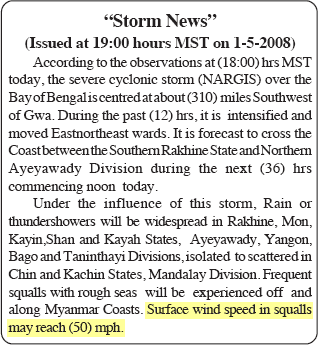 |
| Old news. At the time this warning was issued in the official New Light of Myanmar newspaper, the storm was clocked at about 90 mph, according to one cyclone tracking group. The speeds rose steadily to a peak of about 120 mph. |
Regardless of how speedily Burma government officials fully heed the international call for acceptance of aid, the efforts are in place to collect donations. One group of MBA graduates has set up an interest-free micro-credit fund, according to The Myanmar Times. And some groups, like the Foundation for the People of Burma, actually give frequently updated accounts of their successful relief efforts. [back to top]
We suggest you give generously to the Foundation for the People of Burma. FPB provides humanitarian aid to Burmese people of all ethnic backgrounds and beliefs.
Just as Cyclone Nargis was moving towards Burma on May 1, George W. Bush froze the assets of two state-owned companies involved in Burma’s jade, gemstone, and pearl trades. (Assets of a third company, involved in timber, also were frozen.) The remarks were made, according to this Associated Press story, during an event marking Asian Pacific American Heritage Month.
 |
| Chilly. George W. Bush announces a freeze on Burma state-owned assets during a ceremony for Asian Pacific American Heritage Month. (White House photo by Joyce N. Boghosian) |
State-owned firms previously were exempt from administration action. The companies targeted are Myanmar Gems Enterprise, Myanmar Pearl Enterprise, and Myanmar Timber Enterprise. U.S. assets belonging to the companies are blocked and Americans are banned from doing business with them. Apparently preoccupied with the aftermath of Nargis, no response by Burma officials was issued regarding the asset freeze. [back to top]
Gary Roskin’s April 30 JCKonline story gives a detailed account of the challenges facing search operations in the aftermath of flooding in which dozens of tanzanite miners were trapped and killed in late March. The deaths occurred in Block B of the Merelani Hills, which is not mined by a single operator, but rather is divided into individually claimed parcels.
We spoke with Hayley Henning, Tanzanite Foundation’s director of retail relations, May 14 to get an update. (The foundation and American Gem Trade Association set up a relief fund shortly after the incident.) According to Henning, the bodies of 57 miners had been recovered, with 17 or 18 miners still unaccounted for. These are the same numbers included in Roskin’s article.
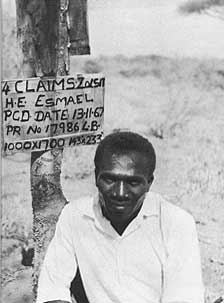 |
| The forerunner of “artisanal” miners who work Block B today, was Habib Esmael, an original claim holder who lost his property when the Tanzanian government nationalized the mine. From our reprint of a chapter by Peter Bancroft. (Photo: Edward Swoboda, 1967; Esmael is not the person pictured here) |
Due to the wet and muddy conditions, after more than 45 days of searching, identification of bodies—and, indeed, ascertaining exactly who is missing, since many workers are itinerant—becomes extremely difficult, Henning said. It can require government involvement in order to verify who owns, operates, and/or labors on a particular parcel. TanzaniteOne, which operates nearby Block C but whose employees were not injured in the flooding, was involved in rescue operations, and has completed a “preventative trench” to avert future flooding of Block B shafts.
The relief fund has been growing, said Henning. “People are so giving when it comes to tragedy. Distribution of these funds will take place once it has been decided exactly how best to spend the money, not only in the immediate future, but for the long-term good of the community.”
Last month we mentioned mining operator Moussa Konate’s endeavors in Mozambique to improve infrastructure in the local community. Similar efforts are afoot at Merelani. A year ago, members of an International Colored Gemstone Association (ICA) mining tour saw for themselves a kind of “before-and-after” example of industry’s community investment. In Robert Weldon’s InColor report on the tour, “East Africa’s gem world uncovered,” he remarks on the “stark contrast” between TanzaniteOne’s Block C, and Block B’s independent operation. Block C appeared “clean, safe, and organized,” although it was closed for the day, “for security” reasons, so the visitors had no chance to talk with TanzaniteOne workers at the mine. Block B, operated by independent “artisanal” miners, appeared to be a dangerous, free-for-all set-up. (Another article about the tour, purportedly from the Guardian, quotes tour members and ICA officials, capturing the depth of their concern.)
Years ago, TanzaniteOne (then known as Afgem) knew it had a public relations problem on its hands, even if its own operation could be compared favorably against so-called artisanal, independent mining operations nearby. That and other factors led to the introduction in 2005 of the Tanzanite Foundation, an ostensibly independent non-profit with many tasks: industry growth and development, protecting consumer interests, “maintain[ing] tanzanite’s good reputation.” Beyond the marketing angle, the foundation—open to all industry players—dedicated itself to “making a meaningful and long standing difference to the lives of the communities at tanzanite’s source.”
The foundation’s accomplishments were demonstrated during the ICA tour, with members being taken to one of the primary schools that had apparently benefited. Tour members also were told about the “building [of] a Merelani community center, schools, medical clinics, and giving mining assistance and advice to small-scale miners,” according to Weldon. Work remains to be done, of course, but the achievements so far have been encouraging.
For more on the inner workings of the tanzanite mines, see “Mining Interrupted” and the companion piece, “The Women of Tanzanite,” both published in Colored Stone, July 2005. For a 2007 overview of the history of tanzanite, see “Romancing a New Stone” from Time Magazine. [back to top]
Two articles covering the ongoing mysteries—and solutions?—behind andesine-labradorite will serve as follow-up on this subject.
And we’re outa here! [back to top]
— End May Newsletter • Published 5/22/08 —
We suggest you give generously to the Foundation for the People of Burma. FPB provides humanitarian aid to Burmese people of all ethnic backgrounds and beliefs. FPB already is distributing food to refugees on the outskirts of Rangoon.
Every gemologist and aficionado of fine colored gemstones holds a special place for Burma in her or his heart. Its production of the most highly valued rubies is legend, having endured at least 1,500 years of human dramatics (Hughes, pp. 304–305), most recently being strained by two centuries of colonial and military rule. Chinese merchants continue to clog the Burma gemstone markets, as voices from inside and outside the region debate the prudence of prohibition—on the eve of a contentious constitutional referendum, scheduled by Burma’s rulers for Saturday, May 10. Well, maybe.
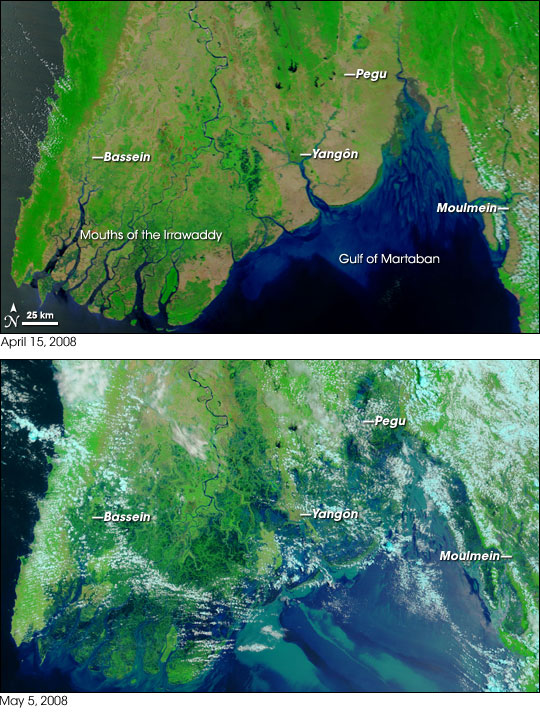 |
| Waterlogged. The photos above use a combination of visible and infrared light to make floodwaters obvious. On May 5, they appear as light and dark blue, swamping the areas that on April 15 were covered with vegetation (bright green) or bare (tan). (Photos: NASA) |
Just a week before the referendum was to take place, Cyclone Nargis (the first named storm to come out of the North Indian Ocean this year) pounded the southern coast of Burma’s populous Ayeyawady state. The region is home to the many mouths of the Irrawaddy River—a “rice bowl” of the country that had fed many hungry mouths. The storm continued its devastation, skirting the coast, and wrecking Burma’s former capital, Yangon (Rangoon).
Estimates of Nargis’s death toll climb by increments of 10,000. As an Australian academic familiar with Burma said in a story yesterday, “We’ll never know how many died,” he said. “This a country that hasn’t had a full census since 1937.”
Statistics—accurate or otherwise (and we at Pala are keepers of our own…)—hardly matter to people who are putting their lives and livelihoods back together. Unpleasantly, but not unexpectedly, Burma’s rulers are reluctant to exhibit impotence by accepting foreign aid—reminiscent of George W. Bush during a particular domestic natural disaster in 2005; the irony of a tongue-lashing from Laura Bush on Monday is self-evident.
The government of Burma should accept this [international aid] team quickly, as well as other offers of international assistance. … It’s troubling that many of the Burmese people learned of this impending disaster only when foreign outlets, such as Radio Free Asia and Voice of America, sounded the alarm. Although they were aware of the threat, Burma’s state-run media failed to issue a timely warning to citizens in the storm’s path.
Regardless of how speedily government officials fully heed the international call for acceptance of aid, efforts are in place to collect donations. And some groups, like the Foundation for the People of Burma, actually give a day-by-day account of their successful relief efforts.
We suggest you give generously to the Foundation for the People of Burma. FPB provides humanitarian aid to Burmese people of all ethnic backgrounds and beliefs.
[back to top]
2015.3 | 2015.2 | 2015.1
2014.3 | 2014.2 | 2014.1 | 2013.3 | 2013.2 | 2013.1 | 2012.3 | 2012.2 | 2012.1
2011.3 | 2011.2 | 2011.1 | 2010.3 | 2010.2 | 2010.1 | 2009.3 | 2009.2 | 2009.1
2008.3 | 2008.2 | 2008.1 | 2007.3 | 2007.2 | 2007.1 | 2006.3 | 2006.2 | 2006.1
2005 | 2004 | 2003 | 2002 | 2001 | 2000
Note: Palagems.com selects much of its material in the interest of fostering a stimulating discourse on the topics of gems, gemology, and the gemstone industry. Therefore the opinions expressed here are not necessarily those held by the proprietors of Palagems.com. We welcome your feedback.